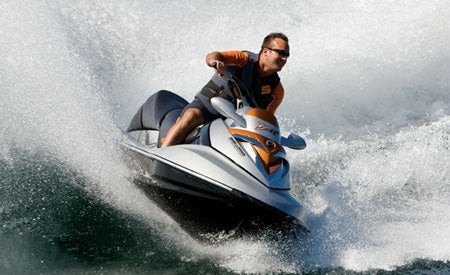Personal Watercraft Winter Storage Tips
The work's not done once riding season is over
Proper storage is essential to make sure your personal watercraft is ready to run again come spring. It prevents rust on internal engine parts, protects the fuel system, keeps your battery in tip-top shape, and maintains your craft’s shiny finish.
Without doubt, the most important item on your checklist is to winterize your engine, but we’ll leave that to your dealer or the handy do-it-yourselfer with a good service manual. Why? Engines have gotten pretty complex, and each manufacturer has their own necessary steps to do the job right, including fogging the engine, draining any leftover water, and lubricating the various fittings that require maintenance. Understand what they are for your particular boat before attempting to do the job yourself, or if in doubt, let your dealer do the job for you.
Beyond the engine, however, there are numerous items on that checklist you can do yourself. Let’s take a look…
 Top off your tank and add a fuel stabilizer like Sta-Bil.
Top off your tank and add a fuel stabilizer like Sta-Bil.Fuel System
Old-school thought is to drain your fuel tank, but today most experts agree the best thing you can do is top off the tank with fresh fuel, then add an appropriate fuel stabilizer, like Sta-Bil. Fuel stabilizer prevents fuel from degrading and oxidizing. Without it, fuel can break down and form gummy residues or varnishy films that can clog carburetors, injectors and fuel lines. The presence of ethanol in gasoline is blamed for exaggerating this effect, making proper fuel storage more essential than ever.
Always mix stabilizer according to the individual manufacturer’s directions. Don’t forget to also stabilize any fuel in approved containers you might not have used during the season.
Battery
 Maintain your charge over the winter with a maintenance charger like the Battery Tender.
Maintain your charge over the winter with a maintenance charger like the Battery Tender.Don’t leave your battery in the boat, or toss it on a shelf in the garage. To ensure the best results come spring, you need to maintain that battery all winter long.
Start by cleaning the terminals. Use a mixture of baking soda and water, and a good brush. When clean and dry, coat the terminals with waterproof grease, and then give the battery a full charge. A charged battery will resist sulfation, the build-up of sulfate crystals on the battery’s internal plates that can shorten the battery’s lifespan, and ultimately make it unable to accept a charge.
Maintain that charge over the winter, checking on your battery every 45-60 days. A discharged battery can actually freeze in cold temperatures, so put it on your calendar. Avoid trickle chargers; they can “cook” the battery if left on too long, buckling the plates and causing them to shed their active material. A better bet is a maintenance charger, like the Battery Tender. If your battery is not a sealed model, don’t forget to monitor the water level. Add distilled water as necessary to keep the internal level above the interior plates.
Hull
Wash and wax your hull to remove any contaminants and protect the boat’s finish. This is also a good time to inspect the surface for any damage. If you find anything, make the repair before winter so you won’t have it hold you up come spring.
 A post-season wash and wax will help keep your PWC looking new.
A post-season wash and wax will help keep your PWC looking new.Make certain to mop up or sponge all remaining water out of the bilge. Left inside it could potentially freeze, causing damage. While working around the engine compartment, look for any loose hose clamps, or damaged wires that could cause a problem down the road. When everything is dry, a light spray of an anti-corrosion spray, like CRC 656, will prevent any rust on your engine’s surface metal.
 Cover up your craft and keep it out of the harsh winter elements.
Cover up your craft and keep it out of the harsh winter elements.If possible, block up the seat on small spacers to allow some air to circulate. This will prevent any condensation from building inside the engine compartment.
Cover your craft to protect it from the elements. One detail owners often overlook is to stuff a rag into the exhaust outlets. This discourages bugs and rodents from making these areas their winter home.
Finally, choose your craft’s location. Ideally, that’s in a protected garage or storage space. If left outside in the elements, consider throwing another tarp over the cover to protect it.
Then, just start counting the days…
Get PersonalWatercraft.com in your Inbox!
Like PersonalWatercraft.com on Facebook
Comments
Most Popular

2025 Yamaha JetBlaster PRO 2-Up Review

2024 Kawasaki Jet Ski STX 160X Review

Remembering the Sea-Doo XP

Whatever Happened to the Wetbike?

2025 Yamaha JetBlaster Review











 Your Privacy Choices
Your Privacy Choices